The Bailiwick of Guernsey, comprising of the islands of Alderney, Brecqhou, Burhou, Guernsey, Herm, Jethou, Lihou and Sark (and smaller islets) has a lot to offer to a visitor. This report is about Guernsey, the principal island, and the tiny Herm.
|
 |
 |
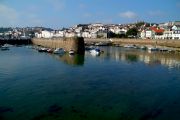 |
 |
 |
 |
 |
 |
Guernsey: St Peter Port's harbour.
 |
 |
'Bienvnus a Dgernesi' means 'welcome to Guernsey' in the island's very own language, called Dgernésiais. It has been spoken on the island for almost a thousand years, and although it had seemed to die gradually, and had been spoken mainly by locals of a wise age, efforts have been recently taken to revive it. For it is a language of the one and only William the Conqueror, a French king, who conquered England in the 11th century and changed the English language forever. Anyway, Dgernésiais is often regarded as Norman French.
And so, the Bailiwick of Guernsey, contrary to common belief, is not part of the United Kingdom. The United Kingdom, as its full name suggests, comprises only the nations located on the island called Great Britain and the northern part of the island called Ireland. However, the Bailiwick of Guernsey is not an independent state. It is a possession of the British Crown, otherwise known as the Crown Dependency. There two other such dependencies: the Bailiwick of Jersey and the Isle of Man. And these are not to be confused with Britain's Overseas Territories, which are in fact colonies. And none of the dependencies are part of the European Union, so tax free shopping is a bliss there.
Yet, I did not go to Guernsey on a shopping spree nor to learn a new language. I just went, because I was curious and I had a few airmiles with some old company, which I was no longer using and had to utilise the miles. And I was so glad that I chose to go. It opened my eyes to a new world. To a new 'version' of British live, a new version of relaxation, a new version of what the fairies were like.
It was a day trip, but if I were to recommend a visit to the Bailiwick of Guernsey, I would suggest to spend a night on each of the following islands: Guernsey, Herm (which I visited) and Alderney and Sark, both of which receive rave reviews from people, who went there. Herm and Sark are car-free, and Herm is also free from motorbikes and bicycles!
|
|
| Favourite spots: |
 |
 |
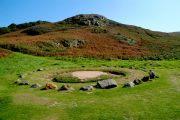 |
 |
 |
 |
 |
 |
Guernsey: Mysterious ancient witches' circle.
 |
 |
By far, the Fairy Ring, or as it is locally known - Le Creux es Faies, believed to be a place of play by fairies was my favourite spot on Guernsey. In fact (oops, this sounds that I might be accurate and worldly), the Guernsey life has been intertwined with stores of mythical beings, witches and fairies, both female and male. Some stories were told that the male fairies would kidnap local women.
Once upon a time, a fairy prince from across the seas put a spell on a pretty local girl called Michelle and kidnapped her, leaving behind a magical pink lily as a compensation to her family. The flower, the Guernsey Lily, now blooms across the island in October.
Other fairy story has it that once an entire army of fairy soldiers invaded the island and killed all the men and married the Guernsey women. This is why the modern Guernseymen are shorter than average, but also a polite and helpful. Local witches benefited too, as they needed no broomsticks to fly. They inherited invisible wings.
|
|
| What's really great: |
 |
 |
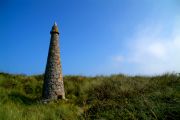 |
 |
 |
 |
 |
 |
Herm: Pierre Aux Rats obelisk
 |
 |
The island of Herm was only 20 minutes away by a small ferry. It was a world in its own right. The minute island had its own flag, much different from the Guernsey one. And the landscape was much different as well. I loved the plains to be walked on and the picturesque bays and beaches on the eastern shore. The entire island had its own chemistry and it felt like time stopped there a few hundred years ago. There were no cars (although the local farmers could use tractors and quad bikes, but these were well hidden in garages when I visited) and no bicycles, so discovering the island on foot without the disruption of someone on wheels anywhere in sight was surreal! Just an open space, almost completely deserted beaches, birds singing and an odd ancient monument sticking from the ground, like this mysterious obelisk, which did not seem to attract attention from any of the other 50 visitors to the island on the day I went to explore it.
|
|
| Sights: |
 |
 |
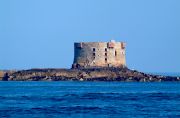 |
 |
 |
 |
 |
 |
Guernsey: one of many forts surrounding the island
 |
 |
There is actually plenty to see on Guernsey and Herm. In summary, the list of things to see on Guernsey is:
Medieval St Peter Port (the capital); Clarence Battery (ruins of French Revolution fort built in 1780); Brehon Tower (1854 AD, no access - can be viewed from a distance); Fort Pezeries (Napoleonic stronghold); Le table des Pions (the Fairy Ring); Batterie Dollamnn (housing 220mm gun); La Gran'mère du Chimquière (4,000 years old statue); Fort Hommet (Victorian fort); St Apolline's Church (1394 AD), Mont Chinchon Battery (Napoleonic gun battery); Fort Le Marchant; Fort Doyle; Vale Castle (600 BC); Les Fouillages (Neolithic burial mound, 4500 BC, unlike any other in Europe).
And on Herm one should not miss: an ancient obelisk, a number of Neolithic chamber tombs and places of bird nesting, including the cute puffins. The bliss of Herm is that it is the smallest of the bailiwick's islands open to public, where cars and bicycles are banned. Only walking is allowed.
|
|
| Accommodations: |
 |
 |
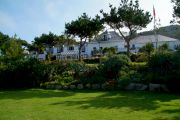 |
 |
 |
 |
 |
 |
Herm: The White House Hotel
 |
 |
I did not stay overnight on Guernsey or Herm. Not this time round. It only dipped my toe in the Bailiwick of Guernsey's universe, just testing the waters. But I will go back one day and will stay at least three days hopping from one island to another to make sure I can taste the local life there properly, and how it is to wake up on those tiny islands. On Herm, there was this White House Hotel, which looked very promising and welcoming. It had a nice, large facade, well groomed gardens and sea views extending all the way to Guernsey. It looked really comfortable inside, and the lobby appeared very civilised with comfy armchairs, although I do not know what the rooms were like.
On Guernsey, there was an entire myriad of hotels ranging from top range five star restorts to smart boutique hotels to basic bed & breakfast options tucked at the end of dark lanes.
|
|
| Nightlife: |
Guernsey has a population of roughly 60,000 and about 30% of that are 20-39 year-olds, and this means that going out and partying is on about the mind of roughly a third of the population, and if the teenagers are added up, then even more. That is a good sign for the night owls.
The nightlife oscillated around pubs, bars and clubs. The pubs were traditionally venues for everyone to gather up and sip pints of beer, larger, stout, bitter or ale while standing and catching up on latest football incidents, shopping deals or sex life mishaps. The Albion House Tavern was one of the best pubs on the island.
Bars on Guernsey were catering mainly for the folk from the financial services industry, which meant that they were posher than average and attracted well dressed and demanding clientele. Bars with good reputation included: Dix-Neuf, Laska's, and the Red Onion.
The clubs for dancing were: the Rogues (large and updated), Les Folies d'Amour (oldest and the best), and the Barbados (relaxed).
|
|
| Hangouts: |
Both Guernsey and Herm had great beaches for wandering, picnicking, chilling, playing or simply hiding from the world. Herm was best for the hiding. The island was very small, and the beaches were almost entirely deserted. There were two beaches, where a few people relaxing and two other beaches where there was not a soul.
The larger Guernsey was not that bad either for hiding. It had more beaches, and small crescent bays in the northern part of the island, which were also rather empty. But of course, there were other sandy shores, mainly those with facilities, where one could sit at a cafe sip rose wines or lovely chilled bitters and watch how people risked getting skin cancer by exposing their body parts to the sun for much too long. One of the cafes was called the Mirage. Staff there was friendly and well informed about activities on the beach and the entire island. A few yards of the cafe, there was an observation terrace. Really cool for taking those photographs.
|
|
| Restaurants: |
 |
 |
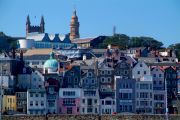 |
 |
 |
 |
 |
 |
Guernsey: St Peter Port's harbour front
 |
 |
I ate at the Thai restaurant right across St Peter Port's harbour. It was called Sawadti, which is a very funny transliteration of the Thai word 'welcome'. The place was open for lunch and dinner with a break between. The menu was comprehensive and contained all the standard Thai dishes, including my favourite spicy coconut milk-based curries, pad thai, satay sauce dishes and desiccated curry with chicken, deep fried prawns wrapped in paper-rice pastry, spicy fishcakes, etc. The main dining room was upstairs with a few tables right at the windows overlooking the harbour, almost all the way to the Herm island. The restaurant was not expensive and although the floor was uneven, making the tables wobble considerably, the service was efficient and the personnel were friendly and attentive.
I ordered king prawn red curry with sticky rice and started with prawns in paper-rice pastry. And washed it all down with Singha beer. The food was delicious and met my ridiculously high expectations.
|
|
| Other recommendations: |
The Bailiwick of Guernsey could be reached from the UK by air in a small aircraft. There were two airports; one on Guernsey, the other on Alderney. The Guernsey airport (GCI) was served by a few airlines: Air Southwest (to Plymouth), Aurigny Air Services (Bristol, East Midlands, London Gatwick, London Stansted, Manchester), Blue Islands (Geneva, Isle of Man, Southampton, Zurich), and Flybe (Birmingham, Exeter, London Gatwick, Southampton). I used Flybe from Gatwick, and was neither surprised nor disappointed. But it was a very short flight.
The harbour on St Peter Port had ferry and passenger boat connections with Poole, Portsmouth and Waymouth in the UK, and Barneville-Carteret, Dielette and Saint-Malo in France. There were also connection between the islands within the Bailiwick of Guernsey as well as to the Bailiwick of Jersey.
The Bailiwick is using pound as a its currency, which is pegged to pound Sterling, which is widely used there, but Guernsey pound cannot be used in the UK.
|
|
Published on Friday June 4th, 2010
|
|
 Publish on Facebook
Publish on Facebook
|
Sat, Jun 05 2010 - 04:27 AM
 by jacko1
| A very informative and well written report Krys, some years ago we went on a very cheap one day ferry trip from Torbay to St. Peter Port as I was interested in seeing the WW2 museum, we only had an afternoon to look around and it rained! I still have some Guernsey pound notes from this trip, useless in the UK as you rightly say. A good report. |
| Information: |
| Login if you are a member, or sign up for a free membership to rate this report and to earn globo points! |
|
| Grenada |
|
|
 |
| Guatemala |
|
|
 |
| Guernsey |
|
|
 |
| Guinea-Bissau |
|
|
 |
| Guyana |
|
|
 |
| Honduras |
|
|
 |
| Hong Kong |
|
|
 |
| Hungary |
|
|
 |
| Iceland |
|
|
 |
| India |
|
|
|
|
|
|
|
|
 |
| Indonesia |
|
|
|
|
|

|
